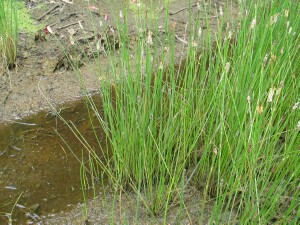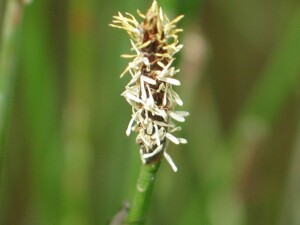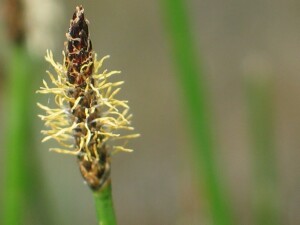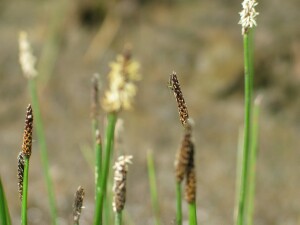Spike-Rush
Back | Salinity Indicator Plants Home | Common name home | Scientific name home | Photo Gallery | Glossary
| Spike-Rush photos | Family name: Sedge (Cyperaceae) |
| Scientific Name: | Eleocharis spp. |  Common Spike-rush plants Photo: A J Brown | |||||
Status: | Includes mainly Australian natives and one introduced. | ||||||
Plant Description: | Annual or perennial rush-like plants, often with rhizomatous root systems. Stems are tufted and erect to spreading, from rounded to angular or flattened. Leaves are reduced to smooth, hairless, bladeless, tubular sheaths with a small apical, mucro point. Flower-head consist of a single and bractless spikelet at the top of each stem. The spikelet is rounded and tapering towards its apex with a few too many flowers arranged spirally. The base of each developing fruit generally supports 6-10 bristles. Fruit is a triangular or lens-shaped nut that is crowned by the persistent enlarged base of the style (the elongated part of the female organ or carpel). | ||||||
Habitat: | Swamps, lake margins, flood-ways and along watercourses. Permanent or seasonal freshwater environments.
| ||||||
Comments: | There are about 10 Spike-rush species occurring in Victoria. The more common and widespread species are Tall Spike-rush (Eleocharis sphacelata), Small Spike-rush (E. pusila), Tuber Spike-rush (E. atricha), Slender Spike-rush (E. gracilis) and Common Spike-rush (E. acutus). Chinese Water Chestnuts are the edible tubers of Eleocharis dulcis. Despite their name, they are actually part of the sedge family (Cyperaceae), rather than the rush family (Juncaceae). They differ from most other sedges in their very reduced leaves and terminal single spikelets without bracts. | ||||||
 Spike of Common Spike-rush showing anthers Photo: A J Brown |  Common Spike-rush flower spike Photo: A J Brown |
|



